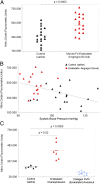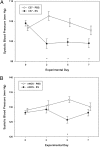Endostatin lowers blood pressure via nitric oxide and prevents hypertension associated with VEGF inhibition
- PMID: 22733742
- PMCID: PMC3396467
- DOI: 10.1073/pnas.1203275109
Endostatin lowers blood pressure via nitric oxide and prevents hypertension associated with VEGF inhibition
Abstract
Antiangiogenesis therapy has become a vital part of the armamentarium against cancer. Hypertension is a dose-limiting toxicity for VEGF inhibitors. Thus, there is a pressing need to address the associated adverse events so these agents can be better used. The hypertension may be mediated by reduced NO bioavailability resulting from VEGF inhibition. We proposed that the hypertension may be prevented by coadministration with endostatin (ES), an endogenous angiogenesis inhibitor with antitumor effects shown to increase endothelial NO production in vitro. We determined that Fc-conjugated ES promoted NO production in endothelial and smooth muscle cells. ES also lowered blood pressure in normotensive mice and prevented hypertension induced by anti-VEGF antibodies. This effect was associated with higher circulating nitrate levels and was absent in eNOS-knockout mice, implicating a NO-mediated mechanism. Retrospective study of patients treated with ES in a clinical trial revealed a small but significant reduction in blood pressure, suggesting that the findings may translate to the clinic. Coadministration of ES with VEGF inhibitors may offer a unique strategy to prevent drug-related hypertension and enhance antiangiogenic tumor suppression.
Conflict of interest statement
The authors declare no conflict of interest.
Figures





References
-
- Folkman J. Tumor angiogenesis: Therapeutic implications. N Engl J Med. 1971;285:1182–1186. - PubMed
-
- Goff MJ, et al. Intravitreal bevacizumab for previously treated choroidal neovascularization from age-related macular degeneration. Retina. 2007;27:432–438. - PubMed
-
- Rajappa M, Saxena P, Kaur J. Ocular angiogenesis: Mechanisms and recent advances in therapy. Adv Clin Chem. 2010;50:103–121. - PubMed
-
- Folkman J. Antiangiogenesis in cancer therapy—endostatin and its mechanisms of action. Exp Cell Res. 2006;312:594–607. - PubMed
MeSH terms
Substances
Grants and funding
LinkOut - more resources
Full Text Sources
Other Literature Sources
Medical
Molecular Biology Databases

